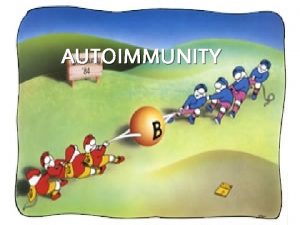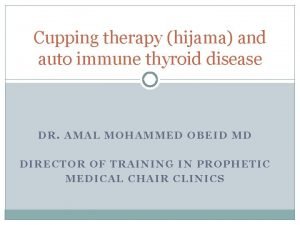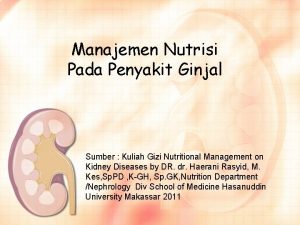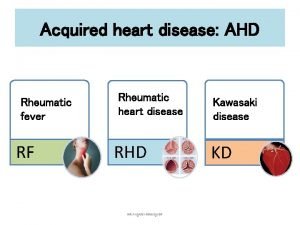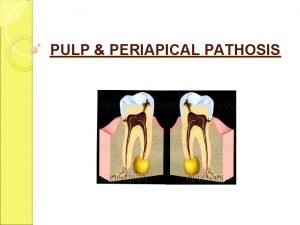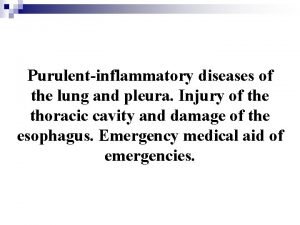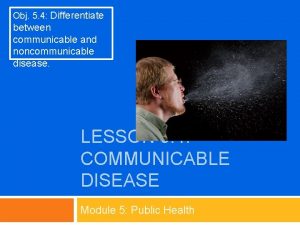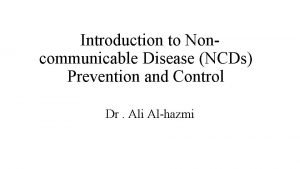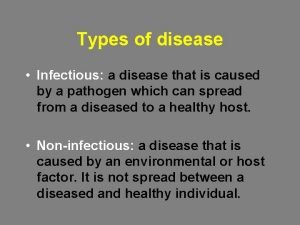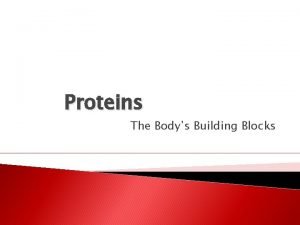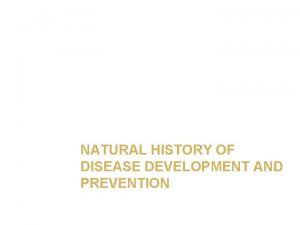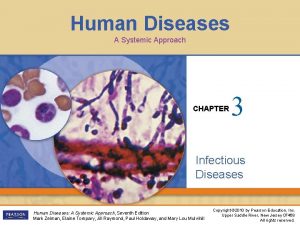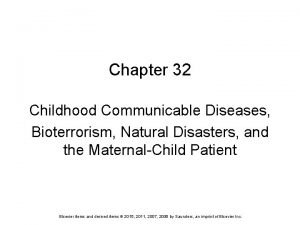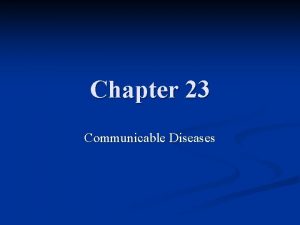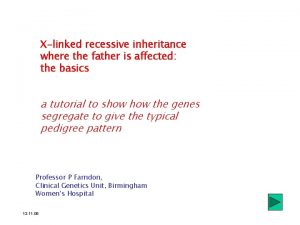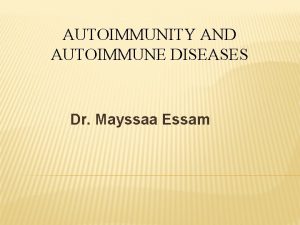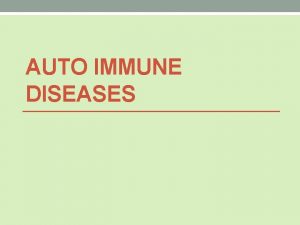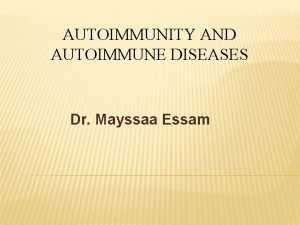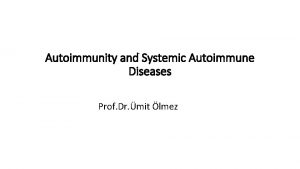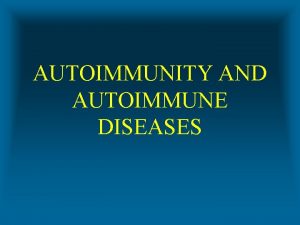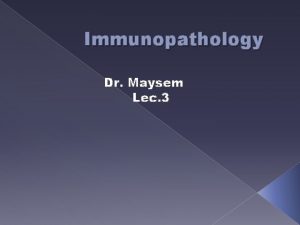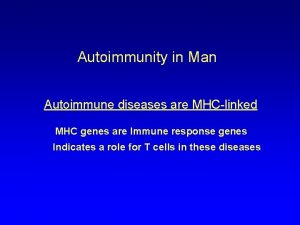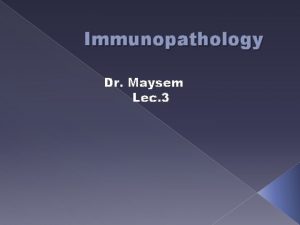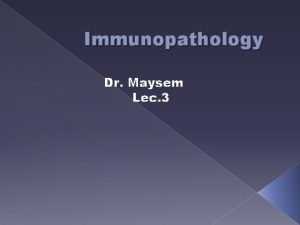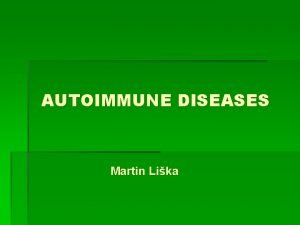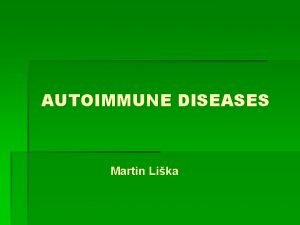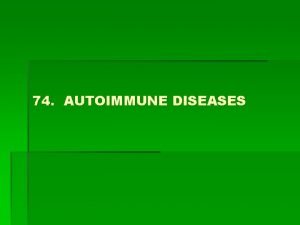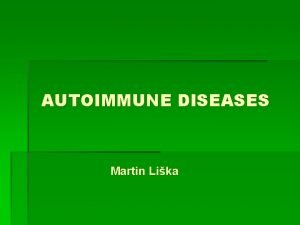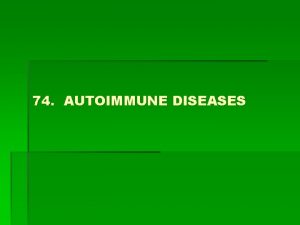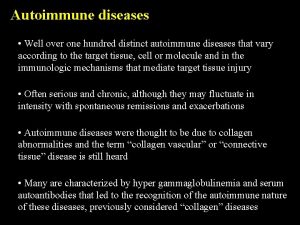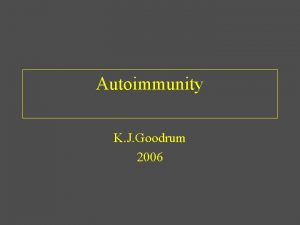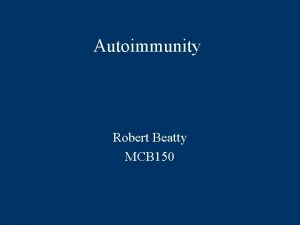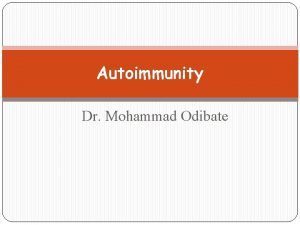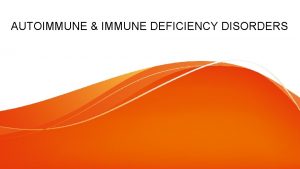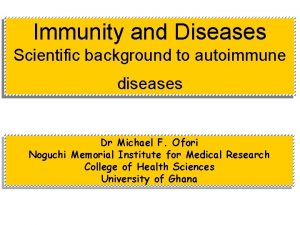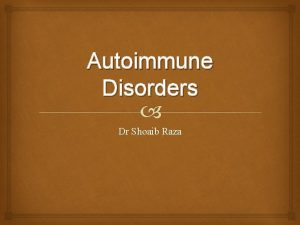Autoimmune Diseases and Mechanism of Autoimmunity Mrs P














































- Slides: 46

Autoimmune Diseases and Mechanism of Autoimmunity Mrs. P. Kalpana Lecturer in Biotechnology Govt. College for Men (A), Kadapa, A. P.

Overview • Introduction to immune response • Tolerance • Autoimmunity (self – nonself) • Types • Possible mechanisms / Factors • Diseases – Diagnosis • Treatment strategies

Immune System • Living organisms provide ideal habitat in which other organisms can grow • Organisms have evolved a complicated, dynamic network of cells, molecules and pathways – Immune system

Immune System Source: https: //www. aids. gov

Immune System • Pathogens evolve countermechanisms to avoid immune destruction • Infections –the immune system is not always successful • Immune response – distinguish between self and non-self

Tolerance • Protection by the immune system to prevent the immune response against the host components • Central tolerance and peripheral tolerance

Tolerance • How does the immune system know self and non-self/foreign? • Clonal selection theory • Positive selection – cells respond to self MHC – clonal expansion • Negative selection – cells which do not bear receptors against self antigens (self tolerance)

Tolerance Source: Figure 16 -1, © 1992, 1994, 1997, 2000, 2003, 2007, 2013 by W. H. Freeman and Company ISBN 13: 978 -14641 -3784 -6

Self – non self • Production of regulatory cells • With the help of education at primary lymphoid organs self antigens and foreign (non-self) antigens can be identified • Establishment of self tolerance

Immune system – Elimination of the pathogens Source: Figure 17. 2, © 2010 John Wiley & Sons, Inc. ISBN-13 978 -0 -470 -48337 -4

Autoimunity • Sometimes immune system go wrong • Failure of immune system to distinguish self – nonself • Destructs self cells and organs Autoimmunity

Autoimmune diseases • Affect 3% - 8% of the individuals in industrialized world Based on number of organs affected 1. Organ specific or localized 2. Systemic

Organ specific or localized • The immune response is directed towards antigens specific for a particular organ Ex: Hashimoto’s Thyroiditis Type I Diabetes Mellitus

Systemic autoimmune diseases • The immune response is directed towards multiple organs or glands Ex: Rheumatoid arthritis Systemic Lupus Erythematosus Multiple Sclerosis

Mechanisms of initiation of Autoimmune disease • Autoimmunity results from failure or breakdown of self tolerance • Genetic factors • Environmental factors • Female Vs Male

Failure of B - cell tolerance Polyclonal B – cell activators • Epstein barr Virus and Cytomegalo Virus • Bacterial antigens such as LPS

Molecular Mimicry • Immune response specific for microbial antigen cross-reacts with self antigen • Conserved sequences • Unintentional autoimmune response Ex: Rheumatic fever

Molecular Mimicry Carbohydrate antigen Streptococcus To control the infection Antibodies produced against the bacterium Cross reaction with host antigens

Availability of sequestered self-antigens • Tolerance is induced in early stages of development • Sequestered or hidden antigens • Release due to injury, trauma or any other reason Ex: sperm antigens, lens of eye, heart muscle etc.

Genetic Factors • Aberrant expression of MHC - II molecules • MHC – I expression – all nucleated cells • MHC – II expression – only on Immune cells • T – cells recognize the antigen only in combination with MHC

Genetic Factors

Genetic Factors • If the MHC are expressed mistakenly on non-immune cells, they may present self antigens to Tcells • Activation of B – cells, Tcyt cells etc. • Leads to autoimmunity

Male Vs Female • Increased frequency with age • More frequent in women than men – Female predominance • Autosomes + XX - Female • Autosomes + XY - Male

Male Vs Female Disease Female to male ratio Hashimoto’s Thyroiditis 50 : 1 SLE 9: 1 Grave’s disease/Hyperthyroidism 7 : 1 Rheumatoid arthritis 3: 1 Multiple sclerosis 2: 1

Male Vs Female - Reasons • Reasons are not entirely understood • Significance gender differences in immune responses • Females mount more vigorous immune response • Hormone differences with respect to autoimmunity (Estrogen Vs Androgen) Ex: SLE Pregnancy +, Menopause -

X-chromosome inactivation • Women have two ‘X’ chromosomes but men have only one ‘X’ chromosome • X-chromosome has thousands of genes essential for cell activity • Women may have double dose of the X –chromosome encoded gene products

X-chromosome inactivation • Actually, women also have same amount of gene products as men – Dosage compensation. • Presence of only one functional Xchromosome in somatic cells • Mary Lyon - 1961

Lyon Hypothesis • Both X chromosomes were active at very early development • As development proceeds one chromosome is turned off • This inactivation is random and irreversible

Multifactorial and polygenic • Autoimmunity does not develop from a single event Initial trigger Formation of auto-reactive T cells Negative selection Failure of Negative selection (under spl. circumstances) Autoimmunity

Clinical associations among autoimmune diseases • More than one autoimmune disease • Autoimmune thyroiditis – gastric parietal cells – adrenal cortex

Rheumatoid arthritis (RA) • Systemic autoimmune disease • Cardiovascular, hematological and respiratory systems are affected • Chronic inflammation of the joints • Female to male ratio is 3: 1 • Diagnosis - Presence of RF antibody, anti-CCP antibodies

Rheumatoid arthritis (RA) Source: http: //www. aihw. gov. au/rheumatoid-arthritis/about/

Systemic Lupus Erythematosus (SLE) • Systemic autoimmune disease • Antibodies against many self antigens • Skin, joints, kidneys, brain and other organs • Female to male ratio is 9: 1 • Presence of Anti nuclear antibodies • Butterfly rash on face

Systemic Lupus Erythematosus (SLE) Source: Page 708, © 2010 John Wiley & Sons, Inc. ISBN-13 978 -0 -470 -48337 -4

Type I Diabetes Mellitus • Organ specific autoimmune disease • Juvenile onset diabetes or Insulin Dependent Diabetes Mellitus (IDDM) • β - cells of the Pancreas • 2 in 1000 children • Autoimmune attack by T-cells • Female to male ratio is 1: 1 or 2: 1

Type I Diabetes mellitus • Hyperglycemia, Ketoacidosis and increased production of Urine • Administration of insulin daily • Undetected for many years – irreparable loss of pancreatic tissue

Grave’s disease • Thyroid gland • Immune attack on TSH receptors • Auto-antibodies bind to TSH receptor • Leads to prolonged stimulation of thyroid cells – Hyperthyroidism • Female to male ratio is 7: 1

Grave’s disease Source: Figure 20 -4, Immunology, 5 th edition, ISBN-13: 978 -0716749479 © 1992, 1994, 1997, 2000, 2003, 2007, 2013 by W. H. Freeman and Company

Hashimoto’s thyroiditis • Immune attack against one or more common proteins of thyroid cells • The resulting destruction of the thyroid gland leads to hypothyroidism • Female to male ratio is 50 : 1

Animal Models • Animal models help in understanding the autoimmunity in humans • Certain autoimmune diseases develop spontaneously in animals • Some of them are induced by certain experimental manipulations

Animal Models • Non obese diabetic mouse –IDDM • (NZB x NZW) F 1 mouse – SLE • Obese strain Chicken–Hashimoto’s • Experimental Autoimmune Encephamyelitis –MS • Autoimmune Arthritis - RA

Treatment • Treatment is aimed at reducing only the autoimmune response • Current therapies – no cure • Reduce the symptoms – to provide acceptable quality of life • Nonspecific suppression of immune system

Treatment • Cannot distinguish the pathological immune response and protective immune response • Immune suppression – increased risk of infections, developing cancer

Treatment • Animal models – Vaccination with T-cell specific for autoantigen • Peptide blockers – competitors of autoantigen • Treatment with monoclonal antibodies • Induction of tolerance – by oral/ mucosal administration of autoantigen

Summary • Introduction to immune response • Tolerance • Autoimmunity (self – nonself) • Types • Possible mechanisms / Factors • Diseases – Diagnosis • Treatment strategies

Reference Books • Kuby Immunology, 7 th Edition, Judith A. Owen, Jenni Punt, Sharon A. Stranford and Patricia P. Jones. • Immunology, 5 th Edition, Richard A. Goldsby, Thomas J. Kindt, Janis Kuby, Barbara A. Osborne. • Cell and Molecular biology, 6 th Edition, Gerald Karp. • Roitt’s Essential Immunology, 10 th Edition, Ivan M. Roitt & Peter J. Delves.
 Autoimmunity literally means
Autoimmunity literally means Cupping therapy for thyroid
Cupping therapy for thyroid Autoimmune diet
Autoimmune diet Symptoms of crohn's disease
Symptoms of crohn's disease Beau's lines autoimmune disease
Beau's lines autoimmune disease They are mrs garcia and mrs castro
They are mrs garcia and mrs castro They are mrs garcia and mrs castro
They are mrs garcia and mrs castro Mrs. darling was ___________ of mrs. s.
Mrs. darling was ___________ of mrs. s. Lifestyle modern
Lifestyle modern Is hemophilia communicable or noncommunicable
Is hemophilia communicable or noncommunicable Section 19-3 diseases caused by bacteria and viruses
Section 19-3 diseases caused by bacteria and viruses Chapter 8 skin disorders and diseases
Chapter 8 skin disorders and diseases Chapter 6 musculoskeletal system diseases and disorders
Chapter 6 musculoskeletal system diseases and disorders Chapter 24 sexually transmitted diseases and hiv/aids
Chapter 24 sexually transmitted diseases and hiv/aids Chapter 22 genetics and genetically linked diseases
Chapter 22 genetics and genetically linked diseases Chapter 21 mental health diseases and disorders
Chapter 21 mental health diseases and disorders Chapter 17 reproductive system diseases and disorders
Chapter 17 reproductive system diseases and disorders Chapter 15 nervous system diseases and disorders
Chapter 15 nervous system diseases and disorders What conditions do fungal organisms favor for growth
What conditions do fungal organisms favor for growth Seborrheic keratoses
Seborrheic keratoses Bruised nail beds milady
Bruised nail beds milady Certain infectious and parasitic diseases
Certain infectious and parasitic diseases Chapter 8 cardiovascular system
Chapter 8 cardiovascular system Chronic pulpitis
Chronic pulpitis Milady chapter 8 skin disorders and diseases
Milady chapter 8 skin disorders and diseases Venn diagram of communicable and non-communicable diseases
Venn diagram of communicable and non-communicable diseases Purulent diseases of lungs and pleura
Purulent diseases of lungs and pleura Tronsmo plant pathology and plant diseases download
Tronsmo plant pathology and plant diseases download Tronsmo plant pathology and plant diseases download
Tronsmo plant pathology and plant diseases download Albugo eye
Albugo eye Venn diagram of communicable and non-communicable diseases
Venn diagram of communicable and non-communicable diseases Functions of vitamins
Functions of vitamins Myth and fallacies about non-communicable diseases
Myth and fallacies about non-communicable diseases Chapter 10 lymphatic system diseases and disorders
Chapter 10 lymphatic system diseases and disorders Different types of diseases
Different types of diseases Quality gurus and their contribution
Quality gurus and their contribution Protein deficiency diseases
Protein deficiency diseases Natural disease
Natural disease Major nutritional deficiency diseases in emergencies
Major nutritional deficiency diseases in emergencies Maxillofacial area inflammatory diseases
Maxillofacial area inflammatory diseases Iceberg phenomenon of disease
Iceberg phenomenon of disease Human diseases a systemic approach
Human diseases a systemic approach Chapter 24 lesson 1 sexually transmitted diseases
Chapter 24 lesson 1 sexually transmitted diseases Classification of periradicular diseases
Classification of periradicular diseases Chapter 32 childhood communicable diseases bioterrorism
Chapter 32 childhood communicable diseases bioterrorism Sarophyte
Sarophyte X linked diseases
X linked diseases
